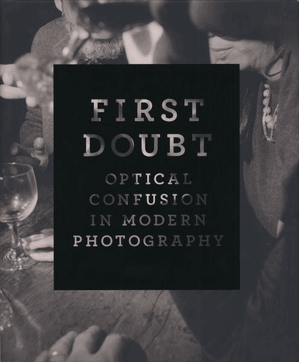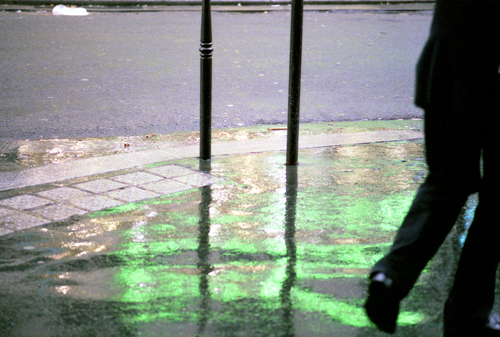 It is always nice to see a fellow photography blogger making things happen. Ofer Wolberger of Horses Think is going to be exhibiting his works at the Michael Hoppen Gallery in London from June 4th to July 25th.
It is always nice to see a fellow photography blogger making things happen. Ofer Wolberger of Horses Think is going to be exhibiting his works at the Michael Hoppen Gallery in London from June 4th to July 25th.
Photographers speak
A new addition to the blogosphere from Dean Brierly, photography editor and writer, Photographers Speak is a collection of interviews that he has conducted with photographers over the years. His second post is an interview with Saul Leiter, whose show at the Fondation Henri Cartier-Bresson was a huge success last year. Leiter has been receiving quite a bit of recognition for his early colour work, which seems to have spent most of its life hanging around in boxes in his apartment. I am glad that he decided to air it out and show it to the world.
Osamu James Nakagawa
 The Japanese-American photographer Osamu James Nakagawa has just been awarded a Guggenheim fellowship to support his work on the Banta and Gama series. With Banta, Nakagawa explores the scars of the Pacific War opposing Japan to America on the cliffs of the island of Okinawa. I was intrigued by the format (which doesn't translate well on a screen) and the fact that these seemingly classic landscape photographs have been "digitally-manipulated" (I would be interested to know how).
The Japanese-American photographer Osamu James Nakagawa has just been awarded a Guggenheim fellowship to support his work on the Banta and Gama series. With Banta, Nakagawa explores the scars of the Pacific War opposing Japan to America on the cliffs of the island of Okinawa. I was intrigued by the format (which doesn't translate well on a screen) and the fact that these seemingly classic landscape photographs have been "digitally-manipulated" (I would be interested to know how).
Review: First Doubt
 "Postmodern interjection, intervention, and manipulation practiced by the society at large have made the image evident more as an artifice than a true recital of the outside world. That makes me happy." Allan Chasanoff
"Postmodern interjection, intervention, and manipulation practiced by the society at large have made the image evident more as an artifice than a true recital of the outside world. That makes me happy." Allan Chasanoff
This quote gives you an idea of the thread that runs through First Doubt, Optical Confusion in Modern Photography, an exhibition held at the Yale University Arts Gallery from October 2008 until January 2009. I didn't make it to New Haven to see the show, but Joshua Chang sent me a copy of the catalogue for helping out with a Tomatsu image, and it has since become one of my favourite photo-books of 2008.
The exhibition was based on the collection donated to Yale by Chasanoff and it covers some pretty diverse territory: portraits, abstracts, landscapes, street photography, and more, from early twentieth century to the mid-1990s. The work is mainly American (many of the big names are present: Ansel Adams, Walker Evans, André Kertész, William Klein), but there is also a healthy representation of Japanese material (Naoya Hatakeyama, Ryuji Miyamoto, Tomio Sieke, Isami Shiroma, Shomei Tomatsu, and Shikanosuke Yagaki).
One of the classic images of postwar Japanese photography is on show here, Tomatsu's Beer Bottle After the Atomic Explosion. A friend of mine wrote her PhD thesis on the differences between Domon Ken and Shomei Tomatsu's photographs of the bombings of Hiroshima and Nagasaki respectively. I have to admit that I didn't make it through all 200 pages, but I completely agree with her basic premise. Domon's images of Hiroshima survivors, particularly of skin transplant operations, were so brutally direct, that they become almost impossible to look at. There is no doubt that the horror of the bombings is conveyed, but they leave me no time to digest their meaning. Tomatsu's treatment on the other hand was indirect, using symbolism to evoke the bombings and the horror of their impact. As you are drawn in to the photographs to decipher what is happening, the space that this creates gives more time for the image to settle and to resonate. Tomatsu's Beer Bottle is the perfect example of that, and for me it is infinitely more powerful and permanent than any of the most brutally direct images of the human and physical devastation of the aftermath of Hiroshima.
What ties the images in First Doubt together is Chasanoff's remarkable eye for the optically confusing image. These are not immediately 'legible' photographs, they all require some mental gymnastics before you can figure out what is going on. Despite the diversity of the material, there is a remarkable coherence here that comes from the resonance between the images. This is one of the strongest overviews I have seen of the optical experimentation in twentieth century photography, and for all the analog purists out there, a testament to how much can be done with a camera and some light.
The book design and typesetting is appropriately clean and simple, given the complexity of these images, and it is beautifully printed (in Connecticut!). The texts by Stephen Zucker and Joshua Chang are both good, and I particularly enjoyed Chasanoff's text, which gives an insight into the incredibly inquisitive and provocative mind of the man who put this collection together.
Rating: Highly recommended
First Doubt, Optical Confusion in Modern Photography (New Haven: Yale University Art Gallery, 2008, hardcover, 220 pages, 94 colour and mononchrome plates).
Review: William Eggleston Paris @ Fondation Cartier
 Three years ago Hervé Chandès, the director of the Fondation Cartier, suggested to William Eggleston over dinner that he shoot a series of photographs of Paris. Eggleston thought, "why not, since I am here?" and now the first group of work from this ongoing commission is being shown at the Fondation Cartier until 21 June.
Three years ago Hervé Chandès, the director of the Fondation Cartier, suggested to William Eggleston over dinner that he shoot a series of photographs of Paris. Eggleston thought, "why not, since I am here?" and now the first group of work from this ongoing commission is being shown at the Fondation Cartier until 21 June.
I was curious to see how Eggleston would approach Paris, a city that seems a little too classically beautiful for his eye. The show begins in dramatic fashion with a sort of antechamber in Eggleston's honour, a waiting room before the art begins. A baby grand piano (Eggleston plays and composes) sits in the middle of the blood-red room, a clin d'oeil to his Red Ceiling. Quotes from an interview with Eggleston are printed on the wall, including one in which he claims that he did not change his style for Paris. Based on the first wall of prints, you have to agree.
The first images in the show are abstracts, flattened perspectives of the corner of a film poster or a graffitied wall. They are pure colour and form, and could have been taken in any big city. I was a little worried that Eggleston might have tried too hard to shut Paris out of these photographs, to ensure that its grandeur didn't disrupt his search for the beauty in the mundane. But as the show progresses, you get more of a sense of Paris seeping through the cracks. We even get treated to a couple of glimpses of the Haussmannian architecture, although they are the most commonplace views possible: graffiti on a rooftop, or a busy street corner in the rain lit by sickly green neon, the winter blues etched into the faces of the passers-by.
While Eggleston's style may not have changed for Paris, I think the principles have intensified over the years. Compared to his earlier work these images are more tightly focused on the visual details which catch his eye, cutting out any context almost completely. His 'democratic' approach is unchanged: classical marble scultpure gets gets the same treatment as a garish, hyper-colour merry-go-round. I think the greatest strength here is his mastery of colour, although the saturation of his early dye-transfer prints is replaced with more muted tones.
The prints are accompanied by a series of notebooks and small painting-drawings, abstractions in the brightest possible felt-tip and fluo pens, said to be inspired by Kandinsky. I don't think these would merit an exhibition on their own, and at first they made me think, "please stick to the day job." However, in the final room, they are juxtaposed with his prints, almost as if to say, "this is how you should been reading my photographs": colour and form are everything.
Apparently the work shown here is just the beginning of this commission on Paris. He has said that he hopes to be able to make this a major corpus and one which will be his "crowning achievement." Judging from the work on show here, he just might pull it off.
Rating: Highly recommended
